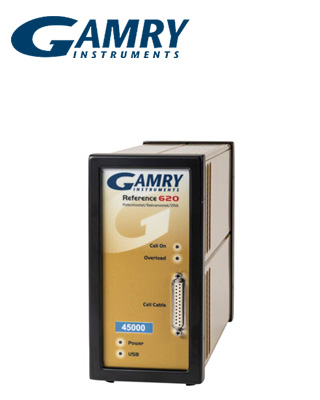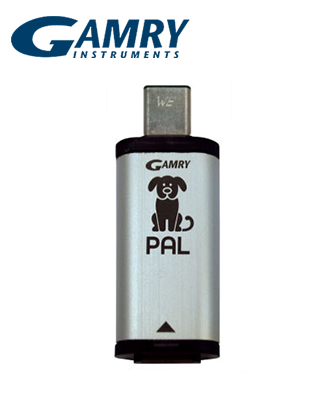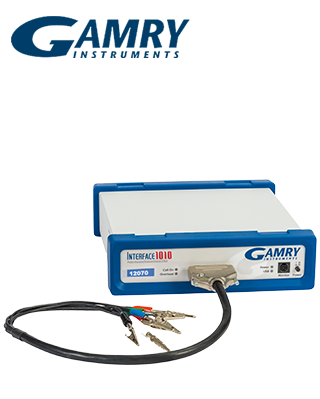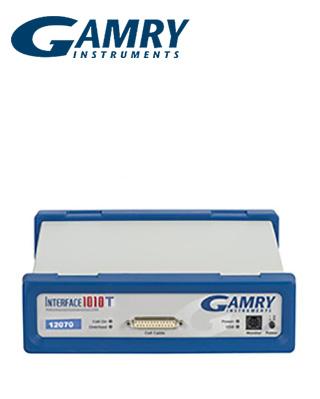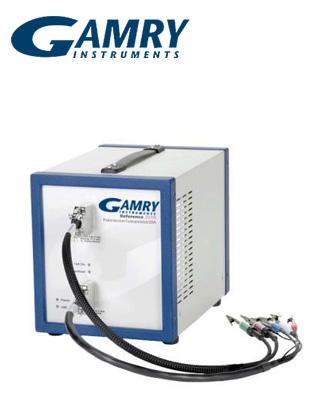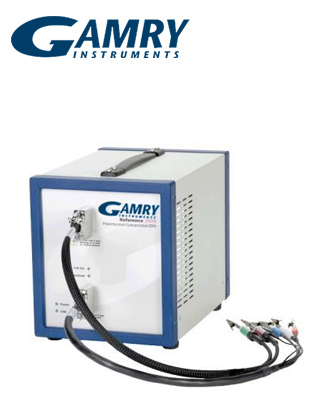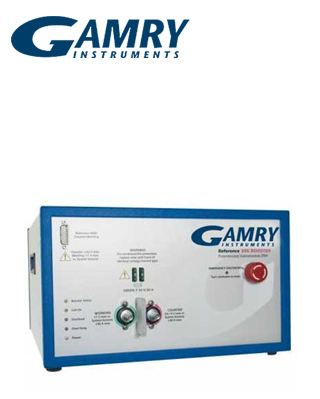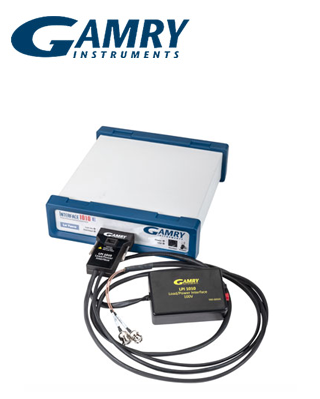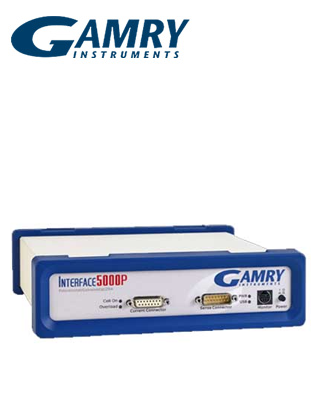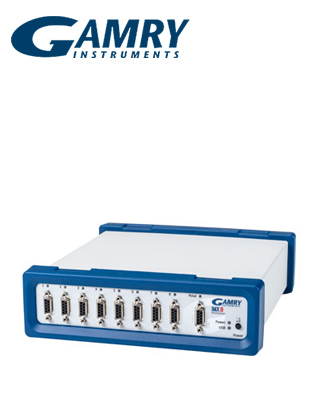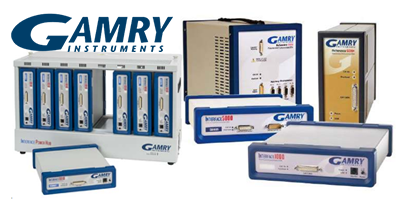恒電位 / 恒電流儀 / 零阻電流計(ZRA)
新型 620 是 Reference 600+™ 的替代產品,是一款高性能的恒電位/定電流/ZRA,特別適合物理電化學、感測器、塗層和腐蝕應用。
620 的主要特點包括 :
- 專為快速、低電流量測而設計
- 最大應用電位 - ±11 V
- EIS - 10 μHz - 5 MHz
適用於下列技術
- 物理電化學
- 脈衝伏安法
- 電化學能源
產品特點
概述
Reference 620 是一款高性能的研究級恒電位/恒電流/零阻電流計(ZRA),專為快速、低電流量測而設計。 它適用於各種應用,例如物理電化學(特別是微電極)、快速循環伏安法、電化學腐蝕、電化學雜訊量測、油漆和塗料以及感測器。 它有許多輔助輸入和輸出,可協助您連接或控制旋轉電極等輔助設備。它還有一個熱電偶輸入,用於溫度測量。
電化學阻抗儀
Reference 620 配備完整,可執行電化學阻抗譜分析。 下圖所示的精確度等值線圖可讓您詳細瞭解儀器在實際情況下的性能表現。
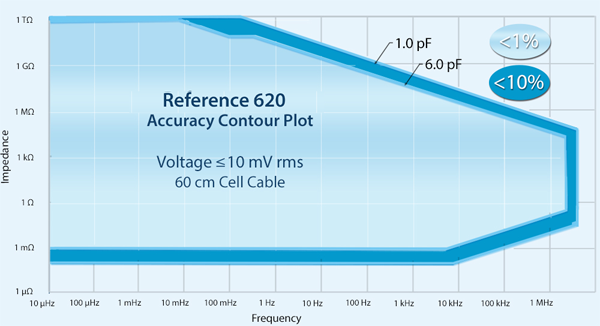
設備除主機系統外,包含一條測試電纜,還提供加長電池電纜(1.5 m、3 m、10 m)選擇。
更多詳細資訊
以下是 I Reference 620型恒電位儀功能的其他詳細資訊。每個要點都包含恒電位儀可執行的技術類型清單。
- 物理電化學 - 諸如週期伏安法、計時電流法、計時電位計等技術,以及這些技術的衍生技術。
- 脈衝伏安法 - 脈衝伏安法、方波伏安法等技術,以及相關的剝離技術,例如陽極剝離伏安法。
- 直流腐蝕 - 進行標準的直流腐蝕測試,例如極化電阻、電位動力、循環極化和電偶腐蝕,以及其它一些測試。
- 電化學能源 - 測試各種電池、燃料電池或超級電容的單個電池和堆疊電池。包括充電、放電、循環充放電技術、靜電位、靜電壓、自放電、漏電率和讀取電池電壓。
- 電化學訊號分析儀 - 專為擷取和分析與時間相關的電化學雜訊訊號而設計。以 0.1 Hz 至 1 kHz 的速率持續監測電池電壓和電流。功能齊備的分析工具提供強大的分析功能,例如統計分析、去趨勢、阻抗譜和直方圖分析。
- 電化學頻率調變 - 一種非破壞性的腐蝕率量測技術。它允許在不事先知道 Tafel 常數的情況下測量腐蝕速率。此外,此技術還可確定 Tafel 常數,並提供 2 個內部有效性檢查。
- 臨界點孔蝕溫度- 控制 Gamry 恒電位儀、TDC5 溫度控制器及相關附件,以自動測量材料的臨界點孔蝕溫度。
- 電化學雜訊 - 較一般的電化學雜訊測試形式。它也是與 ECM8 Multiplexer 相容的電化學雜訊軟體套件。
- 電化學阻抗譜 - 除了莫特-肖特基 ( Mott-Schottky ) 等單頻技術外,還包括用於恆電位、恆電流和混合阻抗譜實驗的實驗腳本。我們還擁有獨特的功率平均多正弦技術,可改善整個頻譜的雜訊比。在分析方面,它提供了用於將頻譜擬合到等效電路模型的工具、用於數據驗證的 Kramers-Kronig 變換和圖形模型編輯器。我們的軟體甚至包含 EIS 模擬的腳本。
- eChemDC Toolkit - 包含 eChemBasic的所有功能,並進一步擴充這些功能,增加進階訊號和資料擷取模式,以簡化執行實驗,如循環伏安法、脈衝伏安法和動態直流腐蝕技術。還包括更先進的停止測試,對快速實驗特別有用。
- eChemAC - 包含 eChemDC Toolkit 的全部功能,並允許進行電化學阻抗譜 (EIS) 和 EFM 實驗。
一般規格
- 2、3 和 4 電極測量。
- 電氣隔離
- 浮動式儀器:與高壓滅菌器、機械應力儀器或管道探針一起使用。
- 可攜式
- 化學教科書大小,重量僅 3 公斤 (6.6 磅)。可輕鬆以 USB 2.0 連接至 Windows 電腦。
- 內建 EIS
- 內建 DDS,可執行 10 µHz 至 5 MHz 的 EIS。
- DSP (數位訊號處理) 模式
- 大量取樣可改善雜訊比,並進行精確的電容量測。
- 電流中斷 iR 補償
- Gamry 恒電位儀及其控制軟體使用控制迴路演算法來精確量測和修正未補償電阻。
- 輔助 I/O
- 透過額外的 I/O 介面控制其他設備:外部訊號輸入、類比電壓輸出、類比電流輸出和數位 I/O 連接器。
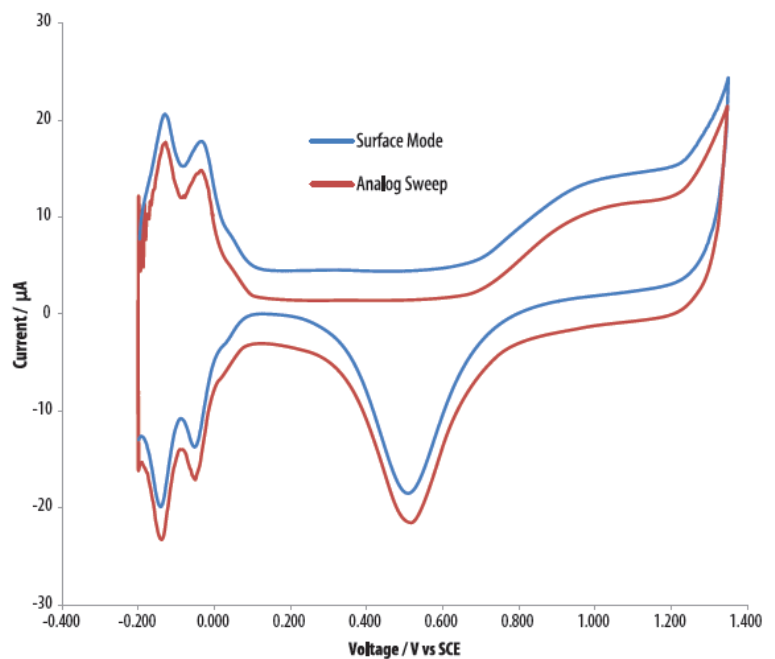
技術規格
|
系統 |
|
|
恒電位儀 |
Yes |
|
恒電流儀 |
Yes |
|
零電阻電流表 |
Yes |
|
浮動(與大地隔離) |
Yes |
|
電極連接 |
2、3、4、5 或 6(包括 Aux 通道) |
|
最大電流 |
±600 mA |
|
電流範圍 |
11 (60 pA - 600 mA) |
|
電流範圍(包括內部增益) |
13 |
|
小電流解析度 |
1.1 aA |
|
最大應用電位 |
±11 V |
|
上升時間 |
<250 ns |
|
最小時基 |
3.333 μs |
|
雜訊與漣波 |
<2 μV rms |
|
重量 |
3 kg |
|
尺寸 |
9 (W) x 19 (H) x 27 (D) cm |
|
|
|
|
控制放大器 |
|
|
相容電壓 |
±22 V |
|
輸出電流 |
> ±600 mA |
|
速度設定 |
5 |
|
|
|
|
EIS測量 |
|
|
EIS 頻率 |
10 μHz - 5 MHz |
|
See Accuracy Contour Plot |
|
|
電壓AC 振幅 電流AC振福 |
3 V maximum 600 mA minimum |
|
靜電計 |
|
|
輸入阻抗 |
>1014 Ω || <0.2 pF |
|
輸入電流(典型值) |
<10 pA |
|
頻寬 |
>15 MHz at -3 dB |
|
CMRR (共模拒次比) |
65 dB (1 MHz) |
|
|
|
|
電位 |
|
|
應用精確度 |
±1 mV ±0.2% of setting |
|
應用解析度 |
200 μV, 50 μV, 12.5 μV/bit |
|
測量精確度 |
±1 mV ±0.2% of reading |
|
測量解析度 |
1 μV, 10 μV, 100 μV, 400 μV/bit |
|
|
|
|
電流 |
|
|
應用/測量精確度 |
±10 pA ± 0.05% of range ±0.2% of value (600 mA - 6 nA) or 0.75% of value (600 pA) or 1.5% of value (60 pA) |
|
應用解析度 |
0.003% full-scale/bit |
|
頻寬 |
>10 MHz (600 mA – 600 μA) |
The new 620, replacement for the Reference 600+™, is a high-performance potentiostat/galvanostat/ZRA particularly suitable for applications in physical electrochemistry, sensors, coatings, and corrosion.
Key features of the 620 include:
- Designed for fast, low-current measurements
- Maximum Applied Potential - ±11 V
- EIS - 10 μHz - 5 MHz
For techniques including:
- Physical Electrochemistry
- Pulse Voltammetry
- Electrochemical Energy
System Highlights
Overview
The Reference 620 is a high-performance, research-grade potentiostat/galvanostat/ZRA designed for fast, low-current measurements. It does well for a variety of applications such as physical electrochemistry (especially at microelectrodes), fast cyclic voltammetry, electrochemical corrosion, electrochemical noise measurements, paints and coatings, and sensors.
It has a number of auxiliary input and outputs designed to help you interface or control ancillary equipment such as a rotating disc electrode. It also has a thermocouple input for temperature measurements.
Electrochemical Impedance Spectroscopy
The Reference 620 comes fully equipped to perform electrochemical impedance spectroscopy. The Accuracy Contour Plot shown below provides a detailed look at the performance you can expect from your instrument in real-world situations. The results include the cell cable.

Options
- Extended Cable Lengths
- Extended length cell cables (1.5 m, 3 m, 10 m) are also available for your convenience.
More Details
Below are additional details regarding the capabilities of the Reference 620 potentiostat. Each bullet point contains a list of the type of techniques available for the instrument to run.
- Physical Electrochemistry - Techniques such as cyclic voltammetry, chronoamperometry, and chronopotentiometry and derivatives of these techniques.
- Pulse Voltammetry - Techniques such as pulse voltammetry, square wave voltammetry, and associated stripping techniques such as anodic stripping voltammetry.
- DC Corrosion - Run standard DC corrosion tests such as polarization resistance, potentiodynamic, cyclic polarization, and galvanic corrosion in addition to a number of others.
- Electrochemical Energy - Test single-cells and stacks of various batteries, fuel cells or supercapacitors. Includes charge, discharge, cyclic charge-discharge techniques, potentiostatic, galvanostatic, self-discharge, leakage rate, and read cell voltage.
- Electrochemical Signal Analyzer - Designed specifically for the acquisition and analysis of time-dependent electrochemical noise signals. Cell voltage and current are continuously monitored at rates from 0.1 Hz to 1 kHz. A full featured set of analysis tools provides powerful analysis features such as statistical analysis, detrending, impedance spectra, and histogram analysis.
- Electrochemical Frequency Modulation - A non-destructive corrosion rate measurement technique. It allows for measurement of the corrosion rate without prior knowledge of the Tafel constants. In addition, the technique determines the Tafel constants and provides 2 internal validity checks.
- Critical Pitting Temperature - controls a Gamry Potentiostat, TDC5 Temperature Controller, and associated accessories to automatically measure the Critical Pitting Temperature of a material.
- Electrochemical Noise - A more general form of electrochemical noise testing. It is also an ECM8 Multiplexer compatible electrochemical noise software package.
- Electrochemical Impedance Spectroscopy - includes experimental scripts for potentiostatic, galvanostatic and hybrid impedance spectroscopy experiments in addition to single frequency techniques like Mott-Schottky. We also have our unique power-leveling multisine technique that improves signal-to-noise across the spectrum. On the analysis side, it provides tools for fitting spectra to equivalent circuit models, Kramers-Kronig transform for data validation and a graphical model editor. Our software even includes a script for EIS simulation.
- eChemDC Toolkit - contains all of the capabilities of the eChemBasic and further extends these capabilities by adding advanced signals and data acquisition modes to simplify implementing experiments like cyclic voltammetry, pulse voltammetry, and dynamic DC corrosion techniques. Also includes more advanced stop tests, particularly useful in fast experiments.
- eChemAC - Includes full capabilities of eChemDC Toolkit plus allows electrochemical impedance spectroscopy (EIS) and EFM experiments.
Other features
- 2, 3, and 4 electrode measurements
- Electrical Isolation
- Floating instrument: use with autoclaves, mechanical stress apparatus, or pipeline probes.
- Built-In EIS
- On-board DDS to perform EIS from 10 µHz to 5 MHz.
- DSP (Digital Signal Processing) Mode
- Oversamples for improved signal-to-noise and accurate capacitance measurements.
- Current Interrupt and Positive Feedback iR Compensation
- Gamry potentiostats and their controlling software use control loop algorithms to accurately measure and correct for uncompensated resistance.
- Auxiliary I/O
- Control additional equipment via additional I/O interfaces: external signal input, analog voltage output, analog current output, auxiliary A/D input, and digital I/O connector.
- Warranty
- Protected by 2-year factory service warranty.
Specifications
SYSTEM |
|
| Potentiostat | Yes |
| Galvanostat | Yes |
| Zero Resistance Ammeter | Yes |
| Floating (Isolated from Earth Ground) | Yes |
| Cell Connections | 2, 3, 4, 5, or 6 (includes Aux channel) |
| Maximum Current | ±600 mA |
| Current Ranges | 11 (60 pA - 600 mA) |
| Current Ranges (including internal gain) |
13 |
| Minimum Current Resolution | 1.1 aA |
| Maximum Applied Potential | ±11 V |
| Rise Time | <250 ns |
| Minimum Time Base | 3.333 μs |
| Noise and Ripple | <2 μV rms |
| Weight | 3 kg |
| Dimensions | 9 (W) x 19 (H) x 27 (D) cm |
CONTROL AMPLIFIER |
|
| Compliance Voltage | ±22 V |
| Output Current | >±600 mA |
| Speed Settings | 5 |
EIS MEASUREMENT |
|
| EIS | 10 μHz - 5 MHz |
| EIS Accuracy | See Accuracy Contour Plot |
| Voltage AC Amplitude | 3 V maximum |
| Current AC Amplitude | 600 mA maximum |
ELECTROMETER |
|
| Input Impedance | >1014 Ω || <0.2 pF |
| Input Current (typical) | <10 pA |
| Bandwidth | >15 MHz at -3 dB |
| CMRR | 65 dB (1 MHz) |
POTENTIAL |
|
| Applied Accuracy | ±1 mV ±0.2% of setting |
| Applied Resolution | 200 μV, 50 μV, 12.5 μV/bit |
| Measured Accuracy | ±1 mV ±0.2% of reading |
| Measured Resolution | 1 μV, 10 μV, 100 μV, 400 μV/bit |
CURRENT |
|
| Applied/Measured Accuracy | ±10 pA ± 0.05% of range ±0.2% of value (600 mA - 6 nA) or 0.75% of value (600 pA) or 1.5% of value (60 pA) |
| Applied/Measured Resolution | 0.003% full-scale/bit |
| Bandwidth | >10 MHz (600 mA – 600 μA) >0.15 MHz (6 μA)) |


